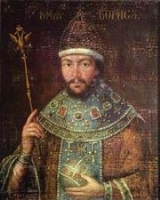
Simeon Bekbulatovich
Encyclopedia

Khan (title)
Khan is an originally Altaic and subsequently Central Asian title for a sovereign or military ruler, widely used by medieval nomadic Turko-Mongol tribes living to the north of China. 'Khan' is also seen as a title in the Xianbei confederation for their chief between 283 and 289...
of the Khanate of Qasim. After the period of the Oprichnina
Oprichnina
The oprichnina is the period of Russian history between Tsar Ivan the Terrible's 1565 initiation and his 1572 disbanding of a domestic policy of secret police, mass repressions, public executions, and confiscation of land from Russian aristocrats...
(1565–1572), Ivan the Terrible named Simeon Grand Prince
Grand Duke
The title grand duke is used in Western Europe and particularly in Germanic countries for provincial sovereigns. Grand duke is of a protocolary rank below a king but higher than a sovereign duke. Grand duke is also the usual and established translation of grand prince in languages which do not...
of All Rus' (1575–1576). He participated in the Livonian war
Livonian War
The Livonian War was fought for control of Old Livonia in the territory of present-day Estonia and Latvia when the Tsardom of Russia faced a varying coalition of Denmark–Norway, the Kingdom of Sweden, the Union of the Grand Duchy of Lithuania and the Kingdom of Poland.During the period 1558–1578,...
as a commander of the main regiment (bol'shoi polk) of the Muscovite army. Subsequently, he was named Grand Prince of Tver' and Torzhok
Torzhok
Torzhok is a town in Tver Oblast, Russia, famous for its folk craft of goldwork embroidery. Population: Torzhok has twenty-two large and medium-sized industrial enterprises. Two of them are especially significant...
(1576–1585). He went blind (or was blinded in 1595) and was tonsure
Tonsure
Tonsure is the traditional practice of Christian churches of cutting or shaving the hair from the scalp of clerics, monastics, and, in the Eastern Orthodox Church, all baptized members...
d as monk under the monastic name Stefan in 1606.
The first mention of Simeon in the sources is a reference to a certain Sail-Bulat in the Supplement to the Nikon Chronicle under 1561 as being in the entourage of his aunt, Princess Kochenei, when she married Ivan IV. Our earliest evidence that he was khan of Qasim comes from a statement that the Russian ambassador to Constantinople Ivan Novosil'tsev said to the Ottoman Sultan Selim II to that effect in 1570.
In 1575 (either September or October), Ivan IV appointed Simeon as Grand Prince of All Rus' and styled himself merely as "Ivan of Moscow". Historians have a number of opinions concerning why Ivan did this. During his one-year "rule" in the Moscow Kremlin
Moscow Kremlin
The Moscow Kremlin , sometimes referred to as simply The Kremlin, is a historic fortified complex at the heart of Moscow, overlooking the Moskva River , Saint Basil's Cathedral and Red Square and the Alexander Garden...
, Simeon married Anastasia Mstislavskaya, the great great granddaughter of Ivan III.
In 1576, Simeon stepped down as Grand Prince of All Rus' and was appointed Grand Prince of Tver' and Torzhok
Torzhok
Torzhok is a town in Tver Oblast, Russia, famous for its folk craft of goldwork embroidery. Population: Torzhok has twenty-two large and medium-sized industrial enterprises. Two of them are especially significant...
. In 1585, Tsar Fedor Ivanovich removed his title as Grand Prince of Tver' and Torzhok and confined him to his estate at Kushalov. In 1595, Simeon went blind. According to Jacques Margeret, Simeon blamed Spanish wine that Boris Godunov
Boris Godunov
Boris Fyodorovich Godunov was de facto regent of Russia from c. 1585 to 1598 and then the first non-Rurikid tsar from 1598 to 1605. The end of his reign saw Russia descend into the Time of Troubles.-Early years:...
sent him for his birthday. When Boris was elected Tsar in 1598, he required those at the court sign a loyalty oath, which prohibited them from recognizing Simeon as tsar or corresponding with him. False Dmitry I required Simeon to be tonsured at the Kirillo-Belozersky Monastery
Kirillo-Belozersky Monastery
Kirillo-Belozersky Monastery , loosely translated in English as the St. Cyril-Belozersk Monastery, used to be the largest monastery of Northern Russia. The monastery was dedicated to the Feast of the Dormition of the Theotokos, for which cause it was sometimes referred to as the Dormition Monastery...
, where he took the monastic name Stefan on April 3, 1606. When Vasilii Shuiskii was elected tsar, he ordered the elder Stefan taken to the Solovki Monastery on May 29, 1606.
In 1612, as the result of a decree issued by Prince D. M. Pozharskii and "on the advice of all the land" (zemskii sobor), Stefan was returned to the Kirilo-Belozersk Monastery. Under Tsar Mikhail Fedorovich, he returned to Moscow and resided in the Simonov Monastery
Simonov Monastery
Simonov monastery in Moscow was established in 1370 by monk Feodor, a nephew and disciple of St Sergius of Radonezh.The monastery land formerly belonged to Simeon Khovrin, a boyar of Greek extraction and progenitor of the great clan of Golovins. He took monastic vows in the cloister under the name...
until he
died in 1616. He was buried in the Simonov Monastery next to his wife, who had died June 7, 1607, after having been veiled as the nun Alexandra.

